|
|
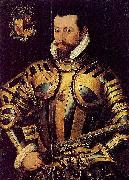 |
Steven van der Meulen
|
|
(b. eAntwerp - d. London, e1563-64) was a Dutch artist active c. 1543-1564. He gained prominence in England in the first decade of the reign of Elizabeth I as one of many Flemish artists active at the Tudor court. He is best known for the "Barrington Park" portrait type of Elizabeth I and for three-quarter length portraits of members of the English court in the first half of the 1560s. A recently discovered will indicates that he died in London between October 1563 and January 1564.
|
|
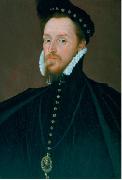 |
Steven van Herwijck
|
|
(Utrecht c. 1530-London 1565/67), was a Netherlandish sculptor and gem engraver famous for his portrait medallions and medals. It has recently been suggested that he is the "famous paynter Steven" mentioned in an inventory of 1590, who has traditionally been identified as Steven van der Meulen.
Van Herwijck worked in Italy in 1557 and returned to Utrecht in 1558, when he was made a Master of the artists' Guild of St. Luke. His earliest surviving medals, of George van Egmond, Bishop of Utrecht, and Engelken Tols, date from this year. In 1559 he relocated to Antwerp. Nine medals survive of his work there, including a portrait of Jacobus Fabius. Fleeing religious persecution, he went to Poland in 1561 where he made medallions of King Sigismund II and other members of the Polish royal family. |
|
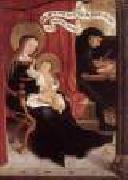 |
STRIGEL, Bernhard
|
|
German Northern Renaissance Painter, ca.1460-1528..Painter, son or nephew of Hans Strigel II. His training with Hans Striegel II shows stylistically in his early works in the Grisons, e.g. the Last Judgement (1486; Brigels, pilgrimage chapel of St Eusebius) and an altarpiece at Disentis (1489; St Johann Baptist). In the 1480s and 1490s he also worked in the studio of Ivo Strigel. Motifs in his pictures stem from engravings by Martin Schongauer and from Ulm book woodcuts. He met Bartholomus Zeitblom as a fellow worker on the high altar (1493-4) of Blaubeuren Abbey, both being influenced by Netherlandish art: Zeitblom by Rogier van der Weyden but Strigel primarily by Dieric Bouts. This influence is also seen in his Adoration of the Magi altarpiece (c. 1500; Memmingen, Stedtmus.). The altar of the Virgin for the monastery at Salem (1507-8; Salem, Schloss) has links with D?rer's graphic work: an increasing three-dimensionality and monumentalization of the objects and figures, and their disposition in space. |
|
 |
STRIGEL, Hans II
|
|
German painter, Swabian school (active 1450-1480 in Memmingen). Painter. The panels of the Montfort-Werdenberg Altarpiece and a Deposition mural (1477), fragment of a series in the church at Tiefenbach, Allgäu, are documented as his. They show an artist in the tradition of Hans Multscher, using strongly foreshortened perspectives for an emphatic relaying of realities. In the 1470s he attempted to tone down the contrasts, to organize his figures after the manner of the Master of Sterzing: a change of style shown in the panels of the Mickhausener altar (Budapest, Mus. F.A.) and the Saints and Passion scenes in the Oberhaus-Museum |
|
|
|
 |
STUBBS, George
|
|
English Romantic Painter, 1724-1806
English painter, draughtsman and printmaker. His study of anatomy enabled him to paint horses, dogs and wild animals with unsurpassed truth to nature, while his innate sense of design enabled him to achieve graceful, rhythmic compositions. His contemporary reputation was chiefly based on portraits of horses and dogs; but he also painted human portraits, conversation pieces and imaginative subjects with animals. |
|
|
|
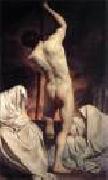 |
SUBLEYRAS, Pierre
|
|
French Painter, 1699-1749
was a French painter, active during the late-Baroque and early-Neoclassic period, mainly in Italy. Subleyras was born in Saint-Gilles-du-Gard, France. He left France in 1728, having carried off the French Academy's grand prix, which carried scholarship for study in Rome. In Rome, he painted for the Elector of Saxony, Frederick Christian, a "Christ's Visit to the House of Simon the Pharisee" , (later engraved by Subleyras himself), this work procured his admission into the famed Roman artists guild, Accademia di San Luca. Cardinal Valenti Gonzaga next obtained for him the order for Saint Basil & Emperor Valens (also known as the Mass of St. Basil , which was executed in mosaic for St Peter's. Another masterpiece is his painting of St. Camillo De Lellis coming to the rescue of the diseased at the hospital of the Holy Spirit He was a remarkably incisive portraitist, as evident from the portrait of Pope Benedict XIV or of the obese Cardinal Valenti Gonzaga . The pope himself commanded two great paintings, the "Marriage of St Catherine" and the "Ecstasy of St Camilla", which he placed in his own private apartments. Subleyras shows greater individuality in his curious genre pictures, which he produced in considerable number (Louvre). |
|
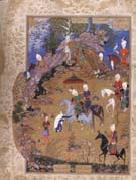 |
Sultan Muhammad
|
|
Persian Painter, active ca.1505-1550
Persian illustrator. He was apparently a native of Tabriz and spent most of his life there. Contemporary sources suggest that he was at the height of his creative powers in the 1520s and 1530s when he was one of the leading painters in the employ of the Safavid shah Tahmasp. Sultan-Muhammad's documented paintings include contributions to a monumental copy (dispersed, ex-Houghton priv. col.) of Firdawsi's Shahnama ('Book of kings') made for Tahmasp between c. 1524 and c. 1529 and paintings from a copy (divided, New York, Met. and Cambridge, MA, Sackler Mus.) of Hafiz's Divan (collected poems), probably executed between 1531 and 1533. Sultan-Muhammad's paintings for these manuscripts demonstrate how the tradition of western Iranian painting as practised in Tabriz, Shiraz and other centres during the 15th century continued to be significant at the Safavid court . |
|
|
|
|
|
|
|
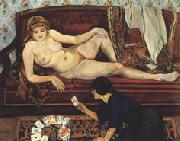 |
Suzanne Valadon
|
|
French Post-Impressionist Painter, 1865-1938
French painter and artist's model. She led a lonely childhood in Paris as the daughter of an unmarried and unaffectionate maid, seeking refuge from her bleak circumstances by living in a dream world. While residing in the Montmartre district of Paris, she became an artist's model, working in particular with those painters who frequented the Lapin Agile. From 1880 to 1887, for example, she sat regularly for Pierre Puvis de Chavannes, posing for both the male and female figures in the Sacred Wood (1884-6; Lyon, Mus. B.-A.). She also modelled for Renoir, Luigi Zandomeneghi, Th?ophile Steinlein, Jean-Louis Forain, Giuseppe De Nittis and Jean-Jacques Henner. No longer able to tolerate the passive role of the model, |
|
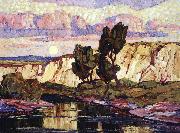 |
Sven Birger Sandzen
|
|
(5 February 1871-19 June 1954), known more commonly as Birger Sandzen, was a Swedish-American painter best known for his landscapes. He produced most of his work while working as an art professor at the Bethany College, Lindsborg, Kansas.
Sandzen was born in Blidsberg, Ulricehamn Municipality, Västra Götaland County, Sweden, the son of a Lutheran minister and his wife, an accomplished watercolorist. A protege of Anders Zorn, Sandzen showed an interest in art at from early age, and at the age of 10 joined Cathedral School (Katedralskolan) situated in Skara, to study art under the tutelage of Olof Erlandsson, a graduate of the Royal Swedish Academy of Arts. After graduating in 1890, Sandzen studied for a short time at the University of Lund before moving to Stockholm. It was his intention to enroll at the Royal Swedish Academy of Arts. However, the waiting list proved too long for him. Instead, he sought out and joined a group of young artists who were studying under Anders Zorn, Richard Bergh and Per Hasselberg. This group would later be known as the Artists League (Konstnärsförbundet).At the end of his studies, Zorn and Bergh recommended that Sandzen complete his painting studies in Paris. In 1894, Sandzen left Stockholm to study under Edmond Aman-Jean who introduced Sandzen to pointillism. |
|
 |
swabian school
|
|
the lovers
1470
the cleveland museum of art, delia and l.e. holden funds |
|
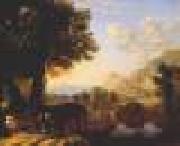 |
SWANEVELT, Herman van
|
|
Dutch Baroque Era Painter, ca.1600-1655
Dutch painter, draughtsman and etcher, active in France and Italy. His first signed and dated works are two views of Paris dated 1623 (Brunswick, Herzog Anton Ulrich-Mus.). He was in Rome from 1629 to 1641. His earliest dated painting there is an Old Testament Scene (1630; The Hague, Mus. Bredius; see fig.), a compositional formula that he often used, with some variations, in Rome. A flat, low foreground is closed on the left by a house and a tree; on the right is a distant hilly scene; and groups of figures are disposed horizontally. This design, derived from Cornelis van Poelenburch, is well suited to van Swanevelt's many landscapes with biblical and mythological subjects. The large tree extending beyond the frame gives a monumental touch to the composition. |
|
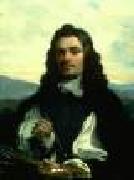 |
SWEERTS, Michiel
|
|
Flemish Baroque Era Painter, ca.1618-1664
Flemish painter, active in Italy, Syria and India. He arrived in Rome in the mid-1640s, perhaps in circumstances similar to those depicted in his painting The Landing (Paris, Louvre). In 1646 he was registered as living in the Via Margutta in the parish of S Maria del Popolo, where documents indicate that he continued to reside until 1651, together with other Flemish Catholics like himself. In 1647 he attended a meeting of the Accademia di S Luca, not as an academician but simply as an associate. The following year he was visited by the Dutch poet Matthijs van de Merwede (1625-?1677), who later recalled the extremely poor welcome he received from the artist. On 1 June 1651 Sweerts was employed by the Antwerp merchant Jan Deutz to represent him at the Papal Customs to collect seven pieces of woollen cloth from Leiden. Sweerts's relationship with the Deutz family was always close: he painted portraits of Jeronimus Deutz (Amsterdam, Rijksmus.) and Balthasar Deutz and a series of the Seven Acts of Mercy for the family; some scholars have identified this series with the cycle of paintings divided between the Rijksmuseum, Amsterdam, the Wadsworth Atheneum, Hartford, CT, and two private collections |
|
|
|
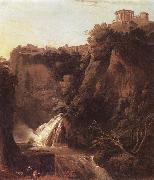 |
Sylvester Shchedrin
|
|
1791-1830,was a Russian landscape painter. Sylvestr Shchedrin was born in St. Petersburg into the family of the famous sculptor Pheodosiy Shchedrin, rector of the Imperial Academy of Arts. The landscape painter, Semion Shchedrin, was his uncle. In 1800, Sylvester Shchedrin entered the Imperial Academy of Arts in St. Petersburg, where he studied landscape painting. Among his teachers were his uncle, Semion Shchedrin, Fedor Alekseev, M.M. Ivanov and Thomas de Thomon.[1]. In 1811e graduated with several awards including the Large Gold Medal for his painting View from Petrovsky Island that gave him a scholarship to study abroad. Lake of Albano, 1825Sylvester left for Italy in 1818, delayed due to the Napoleonic Wars. In Italy, he studied the old masters in Rome; goes to Naples to paint watacolrs ordered by Grand Duke Mikhail Pavlovich of Russia; then return back to Rome. The biggest achievement of that period was New Rome. castle Sant'Angelo (1823) It was such a great success that he has painted 8..10 variations of the painting, each from a slightly different angle and with different details. His pension ended in 1823, but he decided to stay in abroad as a freelance painter. In 1825 he finished his work Lake of Albano that was a new step in his movement to the natural composition. In this painting he relaxed the boundary between subject and background, moved from using the formal colors. Shchedrin had many commissions and grew to become a well-known artist in Italy. He lived in Rome and Naples, working en plein air, drawing bays and cliffs and views of small towns and fishermen villages. One of his favorite motifs were terraces in vines with a view of the sea. Referred as the images of the "Midday Paradis".At the end of the 1820s, Shchedrin began to draw nighttime uneasy, almost nightmarish landscapes, which may have been inspired from his gradually declining health. He died in Sorrento in 1830. |
|
|
|
|
|
|
|
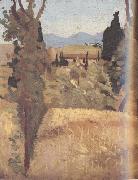 |
Telemaco signorini
|
|
Italian Painter, 1835-1901
was an Italian artist who belonged to the group known as the Macchiaioli. He was born in the Santa Croce quarter of Florence, and showed an early inclination toward the study of literature, but with the encouragement of his father, Giovanni Signorini, a court painter for the Grand Duke of Tuscany, he decided instead to study painting. In 1852 he enrolled at the Florentine Academy, and by 1854 he was painting landscapes en plein air. The following year he exhibited for the first time, showing paintings inspired by the works of Walter Scott and Machiavelli at the Florentine Promotrice. In 1855, he began frequenting the Caffe Michelangiolo in Florence, where he met Giovanni Fattori, Silvestro Lega, and several other Tuscan artists who would soon be dubbed the Macchiaioli. The Macchiaioli, dissatisfied with the antiquated conventions taught by the Italian academies of art, started painting outdoors in order to capture natural light, shade, and color. They were forerunners of the Impressionists who, beginning in the 1860s, would pursue similar aims in France. Signorini was a volunteer in the Second Italian War of Independence in 1859, and afterwards painted military scenes which he exhibited in 1860 and 1861. He made his first trip outside Italy in 1861 when he visited Paris, to which he would often return in the decades that followed. There he met Degas and a group of expatriate Italian artists in his orbit, including Giovanni Boldini, Giuseppe De Nittis, and Federico Zandomeneghi; unlike them, however, Signorini remained rooted in Italy. He became not only one of the leading painters of the Macchiaioli, but also their leading polemicist. Art historian Giuliano Matteucci has written: "If we acknowledge Fattori and Lega as the major creative figures of the macchiaioli, then Signorini must surely be recognized as their 'deus ex machina'", |
|
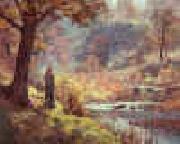 |
Theodore Clement Steele
|
|
1847-1926
Theodore Clement Steele Galleries
Theodore Clement Steele (September 11, 1847-July 24, 1926) was an American Impressionist painter known for his Indiana landscapes. Steele was born in Owen County, Indiana, and later moved to Indianapolis after study in Cincinnati, Chicago and Munich. He is considered to be the most important of the Hoosier Group of painters and his work is widely collected by museums and individuals. Steele earned his living primarily as a portrait painter and his portraits include one of notable Hoosier Poet James Whitcomb Riley and the official portraits of several Indiana governors. Steele exhibited at and was on the art selection for the Louisiana Purchase Exposition in 1904 and was elected to the National Academy of Design in 1913. He enjoyed plein air, or outdoor, painting, which is reflected in many of the landscapes he painted. Steele went through a notable change in style after his return from Munich in 1885. Steele's work, which in the Munich time period sported drab colors and high contrasts, shifted towards a brighter, more vivid color palette after his return to Indiana. Upon T.C. Steele's return, his family lived in the Talbot House, or Tinker Mansion, which is at what is now 16th and Pennsylvania Streets in Indianapolis. In 1898, Steele and J. Ottis Adams bought a home in Brookville, Indiana, which they called "The Hermitage." Steele sold his interest in the home to Adams after the death of his first wife.
He received an honorary master's degree from Wabash College in 1900 and an honorary doctorate from Indiana University in 1916. |
|
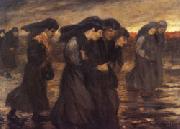 |
theophile-alexandre steinlen
|
|
Swiss-born French Art Nouveau Painter and Printmaker, 1859-1923
was a Swiss-born French Art Nouveau painter and printmaker. Born in Lausanne, Steinlen studied at the University of Lausanne before taking a job as a designer trainee at a textile mill in Mulhouse in eastern France. In his early twenties he was still developing his skills as a painter when he and his new wife were encouraged by the painter Francois Bocion to move to the artistic community in the Montmartre Quarter of Paris. Once there, Steinlen was befriended by the painter Adolphe Willette who introduced him the artistic crowd at Le Chat Noir that led to his commissions to do poster art for the cabaret owner/entertainer, Aristide Bruant and other commercial enterprises. La tournee du Chat Noir avec Rodolphe Salis (1896)In the early 1890s, Steinlen's paintings of rural landscapes, flowers, and nudes were being shown at the Salon des Independants. His 1895 lithograph titled Les Chanteurs des Rues was the frontispiece to a work entitled Chansons de Montmartre published by Editions Flammarion with sixteen original lithographs that illustrated the Belle Epoque songs of Paul Delmet. His permanent home, Montmartre and its environs was a favorite subject throughout Steinlen's life and he often painted scenes of some of the harsher aspects of life in the area. In addition to paintings and drawings, he also did sculpture on a limited basis, most notably figures of cats that he had great affection for as seen in many of his paintings. Steinlen became a regular contributor to Le Rire and Gil Blas magazines plus numerous other publications including L'Assiette au Beurre and Les Humouristes, a short-lived magazine he and a dozen other artists jointly founded in 1911. |
|
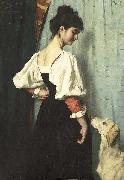 |
Therese Schwartze
|
|
(December 20, 1852, Amsterdam - December 23, 1918, Amsterdam) was a Dutch portrait painter.
Therese was the daughter of Johan Georg Schwartze (1814 - 1874), from whom she received her first training, before studying for a year under Gabriel Max and Franz von Lenbach in Munich. In 1879 she went to Paris to continue her studies under Jean-Jacques Henner. Her portraits are remarkable for excellent character drawing, breadth and vigour of handling and rich quality of pigment.
She was one of the few women painters who had been honoured by an invitation to contribute their portraits to the hall of painters at the Uffizi Gallery in Florence. Some of her best pictures, notably a portrait of Piet J Joubert, and Three Inmates of the Orphanage at Amsterdam, are at the Rijksmuseum, and one entitled The Orphan at the Boyman Museum in Rotterdam.
|
|
|
|
|
|
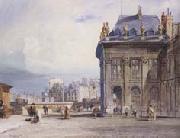 |
Thomas Shotter Boys
|
|
English Engraver, 1803-1874
English painter and printmaker. He was apprenticed on 4 February 1817 to George Cooke. His early training in engraving influenced his future career; his ability to draw a fine line, lay aquatint washes and hand-colour prints was an important factor in the creation of his particularly lucid style of watercolour landscapes and townscapes. At this time Cooke was engraving volumes of picturesque views by Turner and James Hakewell (1778-1843) as well as his own view of the Thames (1822); |
|
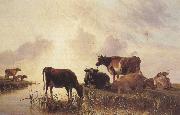 |
Thomas sidney cooper,R.A.
|
|
1803-1902
English painter. He was encouraged in his ambition to become an artist by Sir Thomas Lawrence and the animal painter Abraham Cooper (no relation; 1787-1868). He entered the Royal Academy Schools, London, in 1823. He subsequently taught art in Brussels where he met Eugene Verboeckhoven, whose work had a profound influence on him. Through Verboeckhoven he came to appreciate the work of such 17th-century Dutch painters as Aelbert Cuyp and Paulus Potter. In 1831 he returned to London, exhibiting at the Royal Society of British Artists. He exhibited 48 pictures at the British Institution between 1833 and 1863. The majority of his work was, however, exhibited at the Royal Academy; from 1833 to 1902 he exhibited 266 works there without a break, |
|
|
|
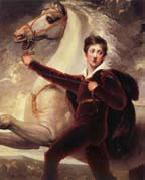 |
Thomas Stothard
|
|
English Neoclassical Painter, 1755-1834,English illustrator, painter and designer. He was one of the most popular, prolific and successful artists of his time and was highly regarded by such contemporaries as Thomas Lawrence and Walter Scott. He was the son of a prosperous publican and completed his apprenticeship as a silk weaver (1770-77), before studying at the Royal Academy, London (1777-c. 1783). From the beginning of his career, book illustration was his main area of activity. His earliest surviving works are in the decorative Rococo mode, but he soon adopted the more idealistic Neo-classicism of John Hamilton Mortimer and James Barry. Together with his friends and near contemporaries, William Blake and John Flaxman, Stothard developed an austere, linear style of draughtsmanship. |
|
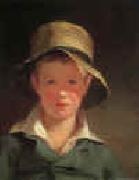 |
Thomas Sully
|
|
1783-1872
Thomas Sully Galleries
Sully became a professional painter at age 18 in 1801. He studied face-painting under Gilbert Stuart in Boston for three weeks. After some time in Virginia with this brother, Sully moved to New York, after which he moved to Philadelphia in 1806, where he resided for the remainder of his life. In 1809 he traveled to London for nine months of study under Benjamin West.
Sully's 1824 portraits of John Quincy Adams, who became President within the year, and then the Marquis de Lafayette appear to have brought him to the forefront of his day. (His Adams portrait may be seen in the National Gallery of Art, Washington.) Many famous Americans of the day had their portraits painted by him. In 1837-1838 he was in London to paint Queen Victoria at the request of Philadelphia's St. George's Society. His daughter Blanche assisted him as the Queen's "stand-in", modeling the Queen's costume when she was not available. One of Sully's portraits of Thomas Jefferson is owned by the Jefferson Literary and Debating Society at the University of Virginia and hangs in that school's Rotunda. Another Jefferson portrait, this one head-to-toe, hangs at West Point, as is his portrait of Alexander Macomb (American general).
Sully's own index indicates that he produced 2631 paintings from 1801, most of which are currently in the United States. His style resembles that of Thomas Lawrence. Though best known as a portrait painter, Sully also made historical pieces and landscapes. An example of the former is the 1819 Passage of the Delaware, now on display at the Museum of Fine Arts, Boston. |
|
|
|
 |
Tobias Stimmer
|
|
(7 April 1539 - 4 January 1584) was a Swiss painter and illustrator. His most famous work is the paintings on the Strasbourg astronomical clock. He died in Strasbourg.
He was born in Schaffhausen, and was active in Schaffhausen, Strasbourg and Baden-Baden as a wall and portrait painter. He made a great number of drawings for woodcuts (Bible scenes, allegories, etc.) which were published by the printer Sigmund Feyerabend in Frankfurt am Main, and Bernhart Jobin in Strasbourg.
Stimmer followed Hans Holbein the Younger, but developed his own mannerism. Among his wall paintings remain the "House zum Ritter" in Schaffhausen, although this was actually much restored and changed.
|
|
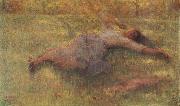 |
Tudor St George Tucker
|
|
1862 - 1906,was the son of Captain Charlton Nassau Tucker, a cavalry officer in the East India Company's service. He came to Melbourne in 1881. He studied at the national gallery school and afterwards at Paris. He returned to Melbourne and about the year 1893 was associated with E. Phillips Fox in the conduct of the Melbourne art school. He was back in London in 1899 working in a studio at Chelsea, and had two paintings in the 1900 Royal Academy exhibition, two in 1901 and one in 1902. He died in London in 1906. He suffered much from ill health and his work is comparatively little known. |
|
|
|
|
|
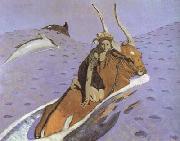 |
Valentin Aleksandrovich Serov
|
|
Russian Painter, 1865-1911
Russian painter, graphic artist and stage designer. As a child he lived in St Petersburg, but he made frequent trips abroad. In 1874 he travelled to Paris with his mother and frequented the studio of the Russian Realist painter, Il'ya Repin. In 1875 the art patron Savva Mamontov invited Serov and his mother to settle at ABRAMTSEVO outside Moscow, where he again had the opportunity to study under Repin and to meet other artists in the Mamontov circle. The Symbolist paintings of Mikhail Vrubel' and the late Impressionist landscapes and figure studies of Konstantin Korovin he saw at Abramtsevo had a lasting influence on the young Serov. From 1880 to 1885 he studied at the Academy of Art, St Petersburg, under Pavel Chistyakov (1832-1919). During the 1880s Serov also travelled abroad and became aware of French Impressionism. He began to use bright colours in portraits of figures seen in dappled sunlight and shade, as in his portrait of Vera Mamontov, Girl with Peaches (1887) and a portrait of Mariya Simonovich, Girl in Sunlight (1888; both Moscow, Tret'yakov Gal.). |
|
|
|
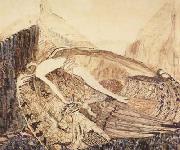 |
Vasily Surikov
|
|
Russian Painter, 1848-1916
Russian painter. He is principally noted for his treatment of episodes from the 17th century and the medieval period of Russian history. These works are remarkable for their thoroughly researched and detailed rendering of settings and costume and the drama of their presentation. Surikov was also an accomplished portrait painter and incorporated a large number of portrait studies into his history paintings. |
|
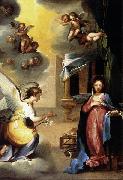 |
Ventura Salimbeni
|
|
(also later called Bevilacqua; 20 January 1568 - 1613) was an Italian Mannerist painter and printmaker and among the last representatives of a style influenced by the earlier Sienese School of Quattrocento-Renaissance.
Salimbeni was born in Siena. He studied painting, together with his half-brother Francesco Vanni, under their father Arcangelo Salimbeni in his native Siena,
He possibly spent some time,in Northern Italy and then moved to Rome in 1588 to work, together with others, on the fresco painting of the Vatican Library under pope Sixtus V.
During 1590-1591, he got a commission by Cardinal Bonifazio Bevilacqua Aldobrandini for paintings in the Roman Jesuit Church of the Gese and the Basilica di Santa Maria Maggiore. These paintings show the influence of the Mannerist Cavalier D'Arpino and Andrea Lillio.
Salimbeni returned to Siena in 1595. Here he became one of the last leaders of the Mannerist school, in this period between Mannerism and Baroque. He was here influenced by Federico Barocci as can be seen in the draperies, highlighted with abrupt changes of light and flickering surfaces, of his painting "Birth of a Virgin" in the San Domenico church in Ferrara (1607-1608).
He completed painting cycles (1595-1602) for Sienese churches such as the oratory in the Santa Trinite. He is known for detailed preparatory drawings, most of which are now in the Uffizi in Florence or the Fine Arts Museum of San Francisco. He started around 1600 painting the scenes from the "Life of St. Hyacinth" for the Sienese church of Santo Spirito. These paintings show the awkward perspective of the style of the Sienese Mannerist painter Beccafumi in the backdrop of buildings and landscape. In Siena, Salimbeni completed several painting cycles for the church of Santo Spirito. He continued to create paintings for churches throughout Italy, including Florence. At the Basilica della Santissima Annunziata di Firenze, he frescoed lunettes (1605-1608) illustrating events in the history of the Servite Order. In the Duomo di San Salvatore, he executed a magnificent John the Baptist.
At about the same time, around 1600, he got an assignment in Assisi for a fresco of the "Resurrection of Christ" and the "Dying Saint Clare is visited by the pope" in the vault of chapel of San Massimo in the Basilica of Santa Maria degli Angeli.
Salimbeni got in 1603 the commission to paint frescoes with scenes from the church's patron saints in the church of Quirico and Giulitta, one of the oldest churches in Siena. As in the church of Santa Trinite, he worked here alongside with the painter Alessandro Casolari.
This was a period on non-stop new assignments : three paintings for the church San Lorenzo in San Pietro in Montalcino, the "Donation of the Keys" (1599), the "Disputa of the Eucharist" (1600) and the "Crucifixion" (1604).
At the same time he was painting the "Vision of Gregory the great" and the "Punishment of David" in the Basilica of San Pietro in Perugia. The papal legate, cardinal Bonifazio Bevilacqua (1571-1627), who had commissioned these paintings, was so pleased that he invested Ventura Salimbeni with the Order of the Golden Spur, a very selective papal order. He was even authorized from now on to name himself Cavalieri Bevilacqua. He painted the canvas of the Ascension of the Virgin (1607) for San Frediano in Pisa.
In 1612 he painted the "Life of Saint Galganus" for the Chiesa del Santuccio in Siena with the hermit saint set in a wooded landscape.
His last work of art was the oil painting the "Marriage of the Virgin" for the Seminario diocesano in Foligno in 1613.
|
|
|
|
|
|
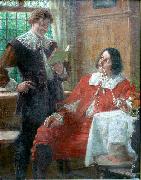 |
Victor Schivert
|
|
(1863-1926?) was a renowned Romanian painter
He painted illustrations of the Thirty Years War.
One of his paintings "Kriegsbeute" was reported stolen in 2005 from Bohemia (Czech Republic).
|
|
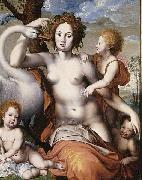 |
Vincent Sellaer
|
|
painted Leda with Swan and Children in1st half of 16th century
|
|
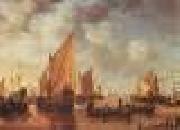 |
VLIEGER, Simon de
|
|
b. 1601, Rotterdam, d. 1653, Weesp..Dutch painter, draughtsman, etcher and stained-glass designer. He was one of the leading marine and landscape artists of the Dutch school and decisively influenced the direction of Dutch marine art during the 1630s and 1640s. His late works anticipated the shift from the monochrome or tonal phase of Dutch marine art to the more classical style of Jan van de Cappelle and Willem van de Velde the younger |
|
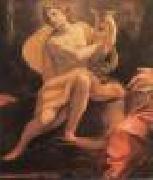 |
VOUET, Simon
|
|
French Baroque Era Painter, 1590-1649
French painter and draughtsman. Although at the time regarded as one of the leading French painters of the first half of the 17th century, he is now known more for his influence on French painting than for his actual oeuvre. He made his reputation in Italy, where he executed numerous portraits for aristocratic patrons and was commissioned for religious subjects. Although the early Italian works show the influence of Caravaggio, his work was subsequently modified by the Baroque style of such painters as Lanfranco and the influence of the Venetian use of light and colour. When he was summoned back to France by Louis XIII in 1627 he thus brought with him an Italian idiom hitherto unknown in France that revitalized French painting |
|
|
|
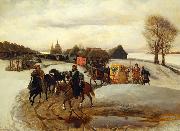 |
Vyacheslav Schwarz
|
|
painted The Spring Pilgrimage of the Tsarina, under Tsar Aleksy Mihailovich in 1868 |
|
|

